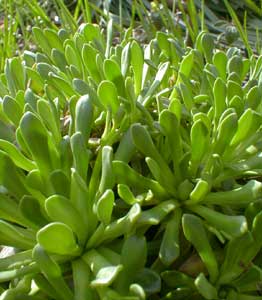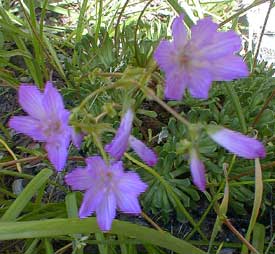 Columbian Bitterroot
Columbian Bitterroot
"Then blooms each thing,
then maids dance in a ring."
-Thomas Nash,
1567-1600
1567-1600
Columbian Bitteroot (Lewisia columbiana var columbiana) is native to Washington, Oregon, California, Idaho & British Columbia, east of the Cascades.
There are two other variants of this species. One is var rupicola with rounded serated leaves, found in Washington & Oregon all along the coast west of the Cascades, having rose-pink to magenta flowers. The other is var wallowensis from Oregon, Idaho & Montana, named for the Wallowa Mountains, generally with white flowers or white with pink stripes.
 All three are very similar in leaf appearance, but var columbiana is much the largest of the three. It clumps as multiple rosettes of long thin succulent leaves in a very tight mound. The easiest method of propogation is to separate the increasing numbers of rosettes into individual plants. This can be done in autumn or late winter, & re-rooted in gravelly soil.
All three are very similar in leaf appearance, but var columbiana is much the largest of the three. It clumps as multiple rosettes of long thin succulent leaves in a very tight mound. The easiest method of propogation is to separate the increasing numbers of rosettes into individual plants. This can be done in autumn or late winter, & re-rooted in gravelly soil.L. columbiana var columbiana is the most widespread of the three variants & grows further north than any other evergreen species of lewisia. It is common in the Columbia River Gorge & adjacent mountains, north to British Columbia, south to northwestern California. It is found at elevations of 100 feet above sea level, upwards to 4,400 feet, always in rocky areas. There is no mistaking it for other species of lewisias, as the thin leaves are quite a contrast to the fatter-leafed L. cotyledon which is the one most commonly available.
The first photo above shows it early in April before it is ready to bloom, at about life-size for the bright leaves. Later in April it sends up little flower stems in the shape of shepherds staffs or fishhooks. In May, as shown in the second photo, the shepherd staffs unfold into tall wiry stems topped with violet-blue flowers, shown here at about thrice life size.
Although flowers are very tiny, they are numerous & brightly colored. Because some of them dangle & others do not, the panicles make a haphazard sloppy presentation. They are followed by black seedheads. The panicles of small flowers can range from violet-purple to white with rosy pink stripes. Ours is a pure almost luminescent violet.
It grows wild on gravelled slopes & stony ledges. In the garden is should be planted in about 70% pea gravel, 30% soil, to duplicate its preferred medium in nature. As it is apt to be more delicate than L. cotyledon for our rainy seasons, I gave it the sunniest spot along the Ledge of Lewisias, where the nearby Japanese maple would never overshadow it, & mixed pea gravel into its immediate planting area as recommended. I even so worry about it some.
It's not at all tolerant of poor drainage, but is highly tolerant of droughty conditions. When not watered it will live on moisture from its own leaves until it shrivels to nearly nothing, but will bounce right back as soon as it rains. It is most naturally predisposed to life on the east side of the Cascades & is most suited to gardens of the inland empire.. But there are also natural populations west of the Olympic Mountains, & it can adapt to Puget Sound rock gardens so long as soil drains radically well, & should do especially well for containers or troughs.
The fleshy, branched taproot was eaten by native peoples, & when dried was a valued trading item. The outer layer of the root is very bitter & white immigrants did not share the native population's delight in this delicacy.
Lewisia x cotyledon 'Hot Pink'